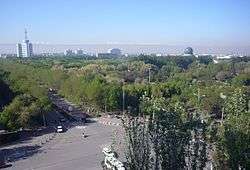Shihezi
| Shihezi 石河子市 • شىخەنزە شەھىرى | |
|---|---|
| Sub-prefecture-level city | |
 | |
 Shihezi Location in Xinjiang | |
| Coordinates: 44°18′N 86°02′E / 44.300°N 86.033°ECoordinates: 44°18′N 86°02′E / 44.300°N 86.033°E | |
| Country | People's Republic of China |
| Region | Xinjiang |
| Government | |
| • CPC Shihezi | Committee Secretary |
| Area | |
| • Total | 460 km2 (180 sq mi) |
| Population [1] | |
| • Total | 640,000 |
| • Density | 1,400/km2 (3,600/sq mi) |
| Time zone | China Standard (UTC+8) |
| Postal code | 832000 |
| Area code(s) | 0993 |
Shihezi (Chinese: 石河子; pinyin: Shíhézǐ; literally: "Stony river banks"; Uyghur: شىخەنزە, Шихәнзә, ULY: Shixenze, UYY: Xihənzə?) is a sub-prefecture-level city in northern Xinjiang, People's Republic of China.
Demography
Its population is about 640,000 (2007), with the majority of the residents being Han Chinese and minorities making up 5.4% of the population.[2] population 2014 1 million
Geography and climate
Shihezi is located at the northern foothills of the middle part of the Tian Shan range approximately 136 kilometres (85 mi) from the regional capital of Ürümqi.
Although Shihezi is almost surrounded from east, west, and north by Changji Hui Autonomous Prefecture (which also includes the city's eastern neighbor, the much older historically Hui town of Manas), it is not a part of it.
Located in an area further from the nearest seacoast than any other region on earth, Shihezi has a continental semi-arid climate (Köppen BSk), with very large temperature differences between summer and winter. Monthly average temperatures range from −15.3 °C (4.5 °F) in January to 25.3 °C (77.5 °F), and the annual mean temperature is 7.39 °C (45.3 °F). Precipitation is very low year-round, with an annual total of only 206 millimetres (8.11 in), compared to the annual evaporation rate, which is usually more than 1,000 millimetres (39 in).[3]
| Climate data for Shihezi (1971−2000) | |||||||||||||
|---|---|---|---|---|---|---|---|---|---|---|---|---|---|
| Month | Jan | Feb | Mar | Apr | May | Jun | Jul | Aug | Sep | Oct | Nov | Dec | Year |
| Record high °C (°F) | 7.6 (45.7) |
6.6 (43.9) |
22.7 (72.9) |
35.4 (95.7) |
37.4 (99.3) |
39.2 (102.6) |
42.2 (108) |
41.0 (105.8) |
39.4 (102.9) |
33.3 (91.9) |
17.5 (63.5) |
8.3 (46.9) |
42.2 (108) |
| Average high °C (°F) | −10 (14) |
−6.3 (20.7) |
4.7 (40.5) |
19.3 (66.7) |
26.3 (79.3) |
30.9 (87.6) |
32.8 (91) |
31.4 (88.5) |
25.4 (77.7) |
15.5 (59.9) |
3.0 (37.4) |
−6.9 (19.6) |
13.8 (56.8) |
| Daily mean °C (°F) | −15.3 (4.5) |
−11.6 (11.1) |
−0.1 (31.8) |
12.1 (53.8) |
18.8 (65.8) |
23.6 (74.5) |
25.3 (77.5) |
23.3 (73.9) |
17.2 (63) |
8.2 (46.8) |
−1.7 (28.9) |
−11.1 (12) |
7.4 (45.3) |
| Average low °C (°F) | −20.8 (−5.4) |
−17 (1) |
−4.9 (23.2) |
5.0 (41) |
11.2 (52.2) |
16.0 (60.8) |
17.7 (63.9) |
15.2 (59.4) |
9.4 (48.9) |
1.8 (35.2) |
−5.7 (21.7) |
−15.5 (4.1) |
1.0 (33.8) |
| Record low °C (°F) | −34.4 (−29.9) |
−36.5 (−33.7) |
−30.5 (−22.9) |
−19.4 (−2.9) |
−0.2 (31.6) |
6.6 (43.9) |
9.6 (49.3) |
3.5 (38.3) |
−0.5 (31.1) |
−8.9 (16) |
−28.9 (−20) |
−36.0 (−32.8) |
−36.5 (−33.7) |
| Average precipitation mm (inches) | 8.6 (0.339) |
8.4 (0.331) |
12.5 (0.492) |
26.2 (1.031) |
29.9 (1.177) |
21.0 (0.827) |
21.5 (0.846) |
15.1 (0.594) |
15.9 (0.626) |
18.9 (0.744) |
16.8 (0.661) |
11.2 (0.441) |
206.0 (8.11) |
| Average precipitation days (≥ 0.1 mm) | 8.4 | 6.6 | 6.0 | 6.1 | 7.2 | 8.1 | 9.1 | 5.9 | 5.0 | 5.2 | 6.2 | 9.0 | 82.8 |
| Source: Weather China[3] | |||||||||||||
The Manas River forms the administrative border between Shihezi City and its eastern neighbor, Manas County. An extensive system of reservoirs (such as the Jiahezi Reservoir (夹河子水库, Jiāhézi shuǐkù, with the dam at 44°27′00″N 86°7′15″E / 44.45000°N 86.12083°E) and irrigation canals has been constructed in the area, supporting irrigated agriculture.
History
Farms surrounding Shihezi fueled the development of the city. These quasi-military structured farms produce materials for the factories that have been the economic driver of the city. In 1974 Shihezi became a city.
Education
Shihezi University is located in Shihezi. It is the 2nd largest university in Xinjiang, with approximately 40,000 students.
Economy
Nowadays textile and food industries are the most important in Shihezi. Railway connection to Wusu and Ürümqi skirts the city, while a United Nation economic development project provided high quality highway systems for the city. Textile industry is the primary employment, although international trade environment on textiles has brought in fluctuations in employment. As a hub to surrounding farms, the city's destiny is currently tied with theirs. Sugar beets are cultivated near Shihezi. Cultivation of cotton in the farms was accelerated in the 1990s and now dominates the economy.[4]
Transport
Shihezi is served by China National Highway 312, the Northern Xinjiang and the Second Ürümqi-Jinghe Railways. Construction to rebuild Shihezi Airport began in May 2012 and the airport is expected to reopen in 2014.
See also
References
- ↑ Copyright by Yingkou People
- ↑ Britannica Online
- 1 2 石河子城市介绍 (in Chinese). Weather China. Retrieved 2011-11-29.
- ↑ Shihezi a 'Shining Pearl in the Gobi Desert' (China.org.cn by staff reporter Wang Qian, October 3, 2004)
External links
- Shihezi economic development zone (simplified Chinese)
- Shihezi party politics public information network (simplified Chinese)
- Map of the City of Shihezi (Chinese)
- Shihezi a 'Shining Pearl in the Gobi Desert'
- Shihezi (China) -- Britannica Online Encyclopedia